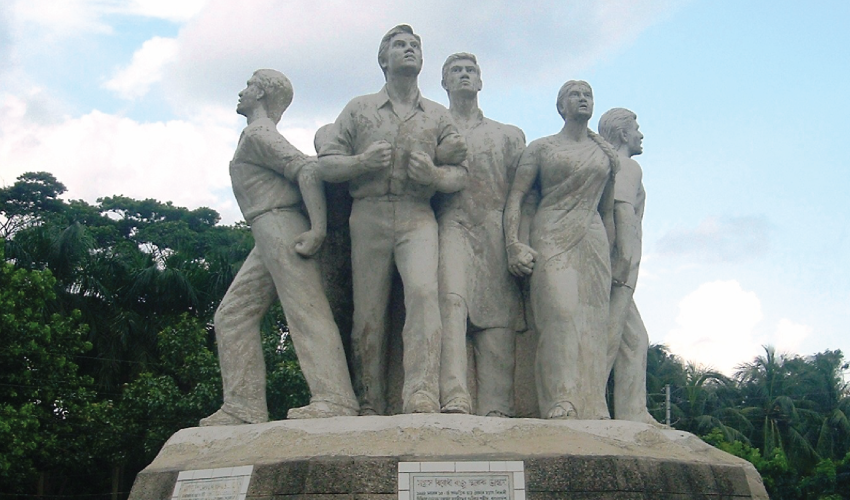Part two of an ongoing series on Sculptures of Bangladesh
By Neha Shamim
Shapla Chottor: A Symbol of Unity and Heritage in Dhaka
Shapla Chottor, or “Lotus Square,” is a renowned landmark situated in Dhaka’s Motijheel commercial hub. This iconic site features a monumental sculpture of a water lily, the national flower of Bangladesh, symbolizing purity, resilience, and unity. More than just a roundabout, Shapla Chottor holds cultural and historical significance, standing as a testament to the nation’s heritage and identity.
The design of Shapla Chottor reflects the deep connection between the Bangladeshi people and their cultural roots. The water lily, prominently displayed on the country’s currency and national emblem, represents the vitality of life and the enduring spirit of the people. The sculpture was commissioned in the 1990s during a period of rapid urbanization in Dhaka. Its establishment aimed to combine the city’s modern aspirations with a tribute to the nation’s natural beauty and cultural identity.
The lotus motif also serves as a reminder of the struggles and triumphs of the Bangladeshi people. It is a subtle yet powerful nod to the Liberation War of 1971, symbolizing hope and renewal in the aftermath of conflict. By placing this iconic structure in the heart of the country’s busiest commercial district, Shapla Chottor became a beacon of national pride and unity.
The water lily sculpture was designed by renowned architect and sculptor Azizul Jalil Pasha. Known for his ability to merge modernist aesthetics with traditional symbolism, Pasha envisioned Shapla Chottor as a space where the chaotic rhythm of city life could intersect with moments of reflection and national pride. The sculpture is crafted from reinforced concrete and metal, with a design that emulates the natural grace of a blooming water lily. The base of the sculpture features a circular pool, which adds an element of serenity to the bustling surroundings. The reflective surface of the water complements the towering petals, creating a sense of harmony and balance. The sculpture’s scale and prominence were intended to draw attention to the cultural and historical importance of the lotus symbol, making it an enduring part of Dhaka’s urban landscape.
Beyond its architectural and artistic appeal, Shapla Chottor serves as a cultural hub and a gathering place for locals and visitors alike. Its central location makes it a prominent meeting point, and its aesthetic appeal provides a momentary escape from the chaos of Dhaka’s streets. Over the years, the site has also become a popular backdrop for photography, media, and public events.
Shapla Chottor holds a special place in the hearts of Dhaka’s residents as a representation of their shared identity. It bridges the gap between the past and present, reminding future generations of the values and history that define Bangladesh.
Today, Shapla Chottor stands as a vibrant symbol of Dhaka’s evolving urban identity. It reflects the city’s journey from its historical roots to its modern ambitions, all while preserving the essence of Bangladesh’s natural and cultural heritage. For those visiting the capital, a trip to Shapla Chottor offers not just a glimpse of its artistic grandeur but also a deeper understanding of the spirit and resilience of the Bangladeshi people.
Raju Memorial Sculpture: A Symbol of Sacrifice and Heritage
The Raju Memorial Sculpture, located at the Dhaka University campus, is a powerful emblem of courage, sacrifice, and the unyielding spirit of the Bangladeshi people. This iconic sculpture commemorates the students and activists who laid down their lives during Bangladesh’s fight for democracy and language rights. It is more than a piece of art – it is a deeply symbolic structure that stands as a reminder of the nation’s struggles and triumphs.
The Raju Memorial Sculpture, often referred to simply as “Raju’s Memorial,” was erected to honor Raju, a young student who became a martyr during the mass protests of the 1990s. These protests were sparked by the government’s decision to introduce privatized education policies, which many believed would hinder the accessibility of education for ordinary citizens. Raju, a student of Dhaka University, was shot during these protests, and his tragic death became a rallying cry for change.
The sculpture also pays homage to the broader history of student movements in Bangladesh, particularly the 1952 Language Movement, during which students fought to establish Bangla as a state language. This historic struggle played a pivotal role in shaping the country’s identity and eventual independence in 1971. The Raju Memorial serves as a convergence point of these narratives, symbolizing the role of youth in shaping the nation’s destiny.
The sculpture was conceptualized and designed by eminent artist and sculptor Shamim Sikder. Completed in 1997, the artwork embodies the raw emotions of struggle and hope. It is made of reinforced concrete and showcases a dynamic composition of human figures standing tall and united, symbolizing the collective resilience of students and citizens in the face of oppression.
Each figure in the sculpture represents different aspects of society, from students and activists to workers and intellectuals. Their outstretched hands and defiant postures symbolize unity and resistance against injustice. The central figure of Raju stands as a beacon of sacrifice and bravery, his pose exuding strength and determination.
The Raju Memorial Sculpture is more than a landmark; it is a sacred space for reflection and remembrance. Every year, on important national days such as Language Martyrs’ Day (February 21) and Independence Day (March 26), students, educators, and citizens gather here to pay tribute to those who sacrificed their lives for the nation’s freedom and rights.
The sculpture’s location within the Dhaka University campus – a historic hub of political activism – adds to its significance. It is a focal point for students, symbolizing the enduring power of youth in bringing about social and political change. Beyond its historical resonance, the sculpture has also become an artistic and cultural icon, frequently featured in literature, photography, and film.
The Raju Memorial Sculpture continues to inspire generations to stand up against inequality and injustice. It is a testament to the power of collective action and the sacrifices made to uphold the values of freedom, democracy, and education. For visitors to Dhaka, this memorial is a must-see, offering not only a glimpse into the nation’s history but also a poignant reminder of the resilience and courage that define the Bangladeshi spirit.
Neha Shamim
- Neha Shamim#molongui-disabled-link
- Neha Shamim#molongui-disabled-link
- Neha Shamim#molongui-disabled-link
- Neha Shamim#molongui-disabled-link













